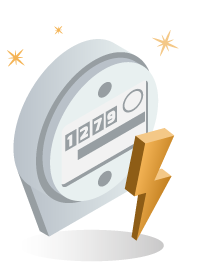Electric Meters: models and how to submit a reading

With the government missing its initial target of having a smart meter in most homes by 2020, many households still have a traditional gas and electric meter installed. Let’s take a look at the different types of electric meters out there and how to submit readings to your energy provider.
How do electric meters work?
An electricity meter monitors the amount of electric energy consumed at your home or business for billing purposes. This is done in kilowatt hours (kWh) and determines how much you are charged at the end of the month, quarter or year.
You can usually find your meter hidden away in a cupboard or in an electric meter box on an exterior wall just outside of your house or flat. You can distinguish the electric meter from a gas meter by the measurement displayed. This will always be kWh for electricity and cubic feet or metres for gas, even though your bill will give you both in kWh.
Energy providers will often estimate electricity usage, rather than check your meter, and base this on either your previous energy consumption or - if you have recently moved house - the average energy use for the area you live.
Taking a meter reading
If you’re looking to save money, it’s a good idea to learn how to read your electric meter, as more often than not, you are likely to be paying for more energy than you are actually using. By submitting your electric meter readings, you can keep on top of how much you should really be paying in comparison to what you are being billed.

With estimated electricity bills based on your previous usage, if you make changes to your habits in an effort to be more energy-conscious, you’re not going to see any immediate change in costs without a smart meter, dual-rate meter or prepayment electric meter.
For this reason alone, it’s important to regularly take meter readings and send them to your supplier. Energy providers will often have a dedicated customer phone number you can call to submit electric meter readings and will often have an online or in-app option to do so too.
If you’re relying on your supplier to make an estimation of your energy usage, you could end up paying more - or in some cases, less - than you should.
And sure, paying less may sound great, but this could actually leave you in debt to the provider and billed a lot more further down the line.
Different types of electric meter
There are a number of different types of electric meter which all vary slightly, but the basics of reading them remain the same.
Standard electric meter
Most UK homes will be equipped with a standard meter, which uses a mechanical display to denote how many units of energy have been used every hour. To take a reading, you will need to write down the first five black numbers displayed.

Dial electric meter
Although it may appear daunting at first, with its small, clock-like dials, it’s actually a lot more straightforward to read a dial meter than you may think. To get your meter reading, you will need to take the number of each of the first five black dials, while ignoring the red.
If the dial is between numbers, always use the lower figure. For example, if the hand is between 4 and 5, the reading will be 4.


Digital electric meter
This meter has a digital LCD display and is very simple to read. To take the meter reading, all you need to do is make a note of the five figures on display. If there is a sixth, red digit, you can just ignore it.

Dual-rate electric meter
These types of meters are usually reserved for Economy 7 and Economy 10 tariffs and display two figures - one for peak times and one for off-peak. To take a reading for this meter, you must make a note of both sets of five-digit numbers.
If it is a digital display dual-rate meter, you may need to press a button to alternate between the peak and off-peak rates.


Prepayment electric meter
Prepayment meters require ‘topping up’ prior to use, just like a ‘pay as you go’ sim card for a mobile phone. Credit is usually charged to a key, card or token, though some suppliers are beginning to offer prepayment by mobile app or text.
While this can be a good option for those who like to budget ahead of time, customers on prepayment meters are likely to be paying over the odds for their energy due to the lack of competitive tariffs available. For this reason, we recommend switching from a prepayment meter to Direct Debit if you are in a position to do so.
Most prepayment meters show the remaining credit on a digital display. There is usually a button you can press to display the meter reading.
Electric meter readings for customers who need extra assistance
If you or a relative or friend are unable to take a meter reading for whatever reason, you should contact your energy provider to see what assistance they can provide. Often, they will offer to send a technician to take a reading on your behalf every three months.
If you are registered disabled, suffer from a chronic illness or elderly, you may qualify for the Priority Services Register and be eligible for any other help and schemes that your supplier participates in.
Depending on the supplier, you may also be able to have the meter relocated to somewhere that it can be easily read from.
What should I do if my electric meter reading is wrong?
If you feel like your meter may be displaying the incorrect reading, contact your supplier directly. They should send an engineer around to check up and make any repairs or adjustments, where necessary.

